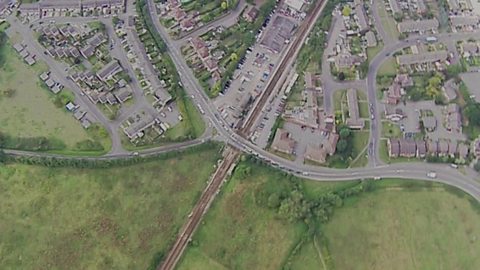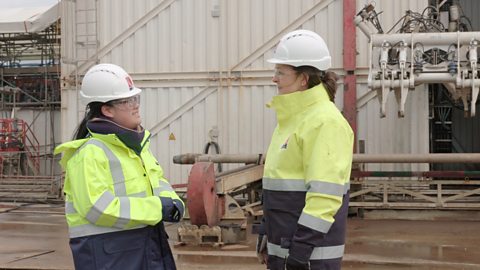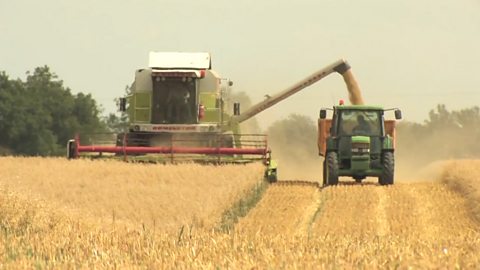Faith: My name’s Faith and I live in the North East. I probably would say that I love the North East only because of the countryside. I read lots of local reports about this new project that wants to reintroduce the lynx cat back in to the wild in Kielder Forest.
Faith: I don’t know much about lynxes, all I know is that they are a wild cat.
Male: The last lynx in Britain was killed for its fur 1300 years ago.
Faith: I thought it would be bigger but it’s not. I thought it would be the size of like a big tiger. But it looks a bit like a cub. And Kielder isn’t far away from where I live so I loved to see lynxes running outside of my house and that would be pretty cool.However, some people say that it’s a bad idea and I want to find out why.
Faith: Rewilding. Is rewilding a good idea?
Faith: Great. Paul from the Lynx Trust is happy to talk to me. But first I want to write down some questions. The Lynx Trust has asked the government if it can conduct a trial to reintroduce the lynx into Northumberland. I want to know why.
Faith: Oh, Paul’s ringing.
Faith: Hi Paul.
Paul O’Donoghue: Hi.
Faith: Dr Paul O’Donoghue is in charge of the project at the Lynx Trust.
Faith: Why do they need to be released?
Paul O’Donoghue: Lynx should be here. They belong here as much as a hedgehog or a badger. Our forests are less healthy without them.
Faith: Letting the lynx be released would it increase any tourism?
Paul O’Donoghue: Lynx are real drivers of tourism. So in Germany where they’ve been reintroduced they generate about £12M a year for tourism which is a massive amount. Imagine that money coming into Kielder Forest.
Faith: How are farmers so against lynxes when they haven’t been around for about 1,300 years?
Paul O’Donoghue: The scientific information says that a lynx kills a sheep about once in every two and a half years. But if a lynx does happen to kill a sheep then we’ll give him all his money back.
Faith: Thanks Paul.
Paul O’Donoghue: You’re very welcome. Bye, bye,
Faith: Bye.
Faith: At this point my mind is definitely for. There’s no reason for anybody to be scared of them and he’s given me a lot of facts. And even a bit of evidence and science definitely helps win me over on that one.
Faith: I’m on my way to Kielder because I need to hear both sides of the story before I make up my mind.
Faith: Kielder Forest is just a 60 mile drive from my school in Gateshead. The lynx Trust wants to release six lynx into this 250 square mile forest because Kielder is big, has few roads and a lot of deer, the lynx’ favourite food.
Faith: Brilliant, a local farmer. Just the person I want to talk to.
Faith: This is huge. There is plenty of room for lynxes. This is amazing.
Faith: I want to find out why Dennis is so against the lynx project.
Faith: Hi Dennis.
Dennis Salt: Hello. And welcome to Rattenraw Farm.
Faith: Thank you.
Faith: What is your view straight up about the lynxes?
Dennis Salt: The straight up view about the lynx I don’t actually think that they should be reintroduced. The Lynx Trust have openly admitted the lynx will definitely predate on sheep and lambs.
Faith: If a sheep was killed by a lynx would the compensation help you or is it just there’s no point?
Dennis Salt: I don’t want sheep killing in the first place. So compensation isn’t a priority.
Faith: Do you see any good points about the tourism side?
Dennis Salt: I think it would actually be a minimal amount of tourism because the lynx are very elusive. Nobody would know where they are apart from the people who are actually tracking them.
Faith: I wonder if the farmer next door agrees with Dennis.
Hi my name’s Faith. So are you for it or against it?
Gerald Todd: Definitely, 100% against it. It will affect our income and our way of life. It’s the final nail in the coffin really. So it’s just a non-starter as far as I’m concerned.
Faith: I’d actually like to take a picture of you guys. I didn’t think it would be like this. I thought I would just make my decision there and then after interviewing both sides. But it’s really difficult. I don’t know how I can choose. I think I need to do a little bit more research before I do definitely make my mind up.
Faith: I’m interested to know if it’s really only farmers in the local area who think this way. I really want to hear some more opinions.Are you interested in animals and nature?
Michelle Grant: Yeah, love it. That’s why I’m here.
Faith: Would you like to see lynxes running wild?
Michelle Grant: Yeah, I’d love it. I think it sounds like a great idea as long as it obviously doesn’t upset the local ecosystem. You know, like it’s not running around tearing up our deer, and that’s a bit of a worry.
Michael Ryan: Certainly all the farmers are against it. But I don’t farm. I’m not a land owner and so I’m fairly neutral.
Michael Brown: It is the most remote village in England and we rely on tourism. And reintroducing the lynxes will bring people into Kielder and it’s better for business and the local community.
Faith: It’s really difficult because the people in the restaurants said they were really looking forward to seeing the lynxes. However, farmer Dennis said you won’t actually be able to see them anyways.
Faith: So, I’ve spoken to people on both sides of the rewilding argument. All their views are convincing but I think I’m ready to make up my own mind.
Faith: At first I was all for the lynxes. I thought they were really cute, loving animals but then speaking to farmer Dennis definitely changed my mind. Because it’s not right. He does this for a living and if the sheep are taken away from him he’s got no living. And it’s exactly the same for the farmers over there, over there and over there.
Faith: I am against this. I don’t want this to go ahead. I don’t think it’s very practical. There’s no need to bring an animal in that was here 1.300 years ago.
Download/print a transcript of the video.
Faith, a student from Tyneside, looks at the pros and cons of rewilding, and investigates plans to reintroduce the lynx into parts of Kielder Forest for the first time in 1,300 years.
First faith talks to a representative of the Lynx Trust and then travels to Kielder Forest to see it for herself. She is initially very positive about the prospect of seeing lynx running wild in the forest again. Then, Faith visits local farmers who are concerned about the threat to their livestock. She also meets tourists and local residents and business people who are positive about the return of the lynx. Finally, she tells us the conclusion she has reached.
This clip is from the series Geography: The Big Issues.
NB: The Lynx Trust proposed the reintroduction of six Eurasian lynx to the Kielder Forest area. The proposal was considered by Natural England who subsequently advised the Secretary of State for Environment, Food and Rural Affairs not to permit the reintroduction. The Secretary of State chose to accept this advice in 2018, so the reintroduction did not proceed. You can find out more here
Teacher Notes
This could be used to set up a class investigation into other types of rewilding in the UK and other parts of the world.
Students could write a list of positive and negative points for rewilding.
Students could then research other examples of rewilding around the world and compare these projects with re-introducing the lynx.
Students could then present their findings.
This might then lead to a debate about conservation projects like this.
Curriculum Notes
This clip will be relevant for teaching Geography at Key Stage 3 and 4 in England, Wales and Northern Ireland and 3rd and 4th Level (S1/S2/S3) in Scotland.
Students and teachers over the age of 16 can create a free Financial Times account. For a Financial Times article about the EU's rewilding plans from 2023, click here.
More from the series Geography: The Big Issues
Change of land use: developing the greenbelt. video
Investigating issues posed by change of land use and the development of the greenbelt.

Use of natural resources: the advantages and disadvantages of fracking. video
A student investigates the pros and cons of fracking by speaking to advocates and opponents.

Agriculture: issues with intensive arable farming. video
Investigating the benefits and drawbacks of intensive arable farming.
